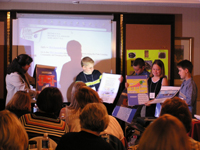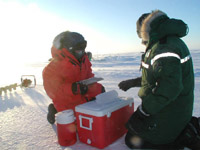 |
|
Illustration by Chris Floud. Copyright 2004
Alaska Science Outreach.
Editor Sonya Senkowsky, a former newspaper reporter, is an independent outreach consultant who helps Alaska researchers develop both traditional and Web-based informal outreach -- from newspaper
features and columns to fieldwork Web sites and blogs.
|
Discussions about opportunities and models for engaging different levels – grades K-5, 6-12, undergraduate non-science, undergraduate and graduate science majors, and the general public– emphasized capitalizing on the ability of polar themes to attract attention and the need for a broad, multi/interdisciplinary approach. With their geographic foundation, the poles encompass a range of content areas: from science to culture and heritage. Workshop participants advocated capturing student interest and increasing science literacy in the general public by linking fascination with polar environments, to improving science, math, reading, and other skills, and integrating polar themes into state and national standards. Polar programming can involve a diverse group of learners in multiple content areas: science as a human endeavor, history and nature of science, science as inquiry, and science and technology. Some projects have already prepared curriculum materials based on education standards using polar themes. For more advanced students, there are exciting opportunities in circumpolar distance learning with web course delivery, as well as other programs such as the University of the Arctic's PhD networks and collaborative field courses. Beyond curricula, the use of polar themes in major competitions such as the National History Month, the National Ocean Sciences Bowl and Intel is a powerful way to expand interest in, and attention on, polar subjects. To bring polar conditions to a wider audience, workshop participants came up with the idea of a semi trailer truck labeled: "Got Snow? – A Traveling Exhibition," outfitted with a snow making machine, polar gear and interactive activities, traveling around the country.
Just as it is important to engage diverse audiences within their own community, establishing connections among local scientists, educators and informal outreach venues, can have long-lasting impacts. These connections build a network that sustains, and encourages further engagement on all sides. Field experiences for students, teachers, and the media alike build life-long advocates of the poles. A rich, multidisciplinary and multilingual web portal where resources can be accessed and opportunities posted, would serve as a central meeting point for a diverse suite of populations and would provide the media – television, radio and print, as well as educators, zoos and museums – with timely, accessible, and meaningful content.
Grades K-5
The K-5 sector is important for polar education and outreach. Children of this age are fascinated with people and
animals living in extreme conditions and they have not yet formed misconceptions/opinions about science. The
integration of unique and unusual experiences like the polar sciences and the IPY is an excellent mechanism to
engage youth. Connections between scientists and educators help make polar science come alive to students, and in
turn, build a community of individuals involved in polar science. Scientists and educators need to be linked in such a
way that they both see benefits from working together.
Specific Proposals:
 |
Classroom image of students presenting their research to teachers at a regional workshop. Courtesy of science teacher Tina King.
|
- Build a community of polar researchers connected with teachers who can assist in outreach activities. Increase awareness that linking research with education and outreach is an integral part in the overall success of science education.
- Provide opportunities for different levels of commitment for scientists and involvement of educators (from emails to video clips to classroom visits and joint curriculum development) – individuals differ in their strengths, abilities and time – but establishing direct communications is important.
- Use graduate students as a bridge between scientists and educators: NSF Graduate Teaching Fellows in K-12 Education (GK-12) project a good resource.
- Networking is essential. Regional workshops – teacher to teacher, teacher with scientist and project – show teachers how to bring polar information to a local level.
 |
Schools on Board student doing
work with ice cores in the field.
Photo courtesy of Lucette Barber.
|
Grades 6-12
Grades 6-12 are in a balancing state. In these grades, teachers need time to teach required material, both to meet standards and to prepare students for assessment. There is an opportunity to develop problem solving and inquiry-based units focused on polar themes that will help both students and teachers meet requirements in interesting ways. Polar themes can also be integrated into existing programs accepted by school districts, where standards are already aligned
Specific
Proposals:
- Incorporate
polar science into existing programs (GLOBE, CoVis, National Ocean
Science Bowl).
- Engage more teachers. Expand Teachers Experiencing
Antarctica and the Arctic (TEA) opportunities. Develop a listserv
to provide units that teachers can use in the classroom.
- Balance "wow" factor of state-of-the-art
technology used in polar science with students’ understanding
that technology is a tool, not a substitute for understanding
science.
- Complement state standards assessments with
polar problem solving units that demonstrate inquiry-based science.
- Attend professional meetings of educators with
polar resources to display and give away (e.g. National Science
Teacher’s Association: NSTA).
 |
Painting by William H. Johnson, (1901-1970), Commodore Peary and Henson at the North Pole, about 1945, oil on paperboard, 27 5/8 x 35 5/8 in., Smithsonian American Art Museum, Gift of the Harmon Foundation.
|
Undergraduate Non-Science Students
Polar themes and activities can be included in undergraduate curricula in a number of way. Many undergraduate institutions require that students complete some sort of general science course. For most students, this is their last encounter with science. This is a perfect opportunity to explore polar issues since they can be broad in scientific focus and relate to large scientific questions that have relevance to the general population.
Polar themes can also be integrated into history, art, and intensive writing programs: reading the early polar exploration literature, reliving expeditions, understanding artists’ representations of the known (e.g. by the Inuit) vs. the unknown (e.g. survival conditions).
Specific Proposals:
- Pose rich questions about broad connections to scientific issues, methods, etc. that educators can use internationally, as well as nationally, that help students learn science and help students make connections to their lives, culture, and communities.
- For undergraduate general science courses: develop curriculum elements that use polar themes to set an interesting context for learning science, help students see connections between science and the world around them, and help students to learn how science works (i.e. latent heat of melting and 0°C summer temperature in central Arctic).
- Have educators and researchers provide resources to a central clearinghouse so that they can be used more widely. Provide materials to help teachers work with students on interdisciplinary classroom investigations that extends their own content knowledge.
Undergraduate Science Majors
Two major areas of opportunity for undergraduate science majors are incorporating more polar science into standard courses, and giving students either hands-on or virtual polar field experiences. Developing opportunities for introductory science courses is important, as this is where students often determine whether to continue in this career or pursue something else. Research and field experiences need to be created for the upper level students.
Specific Proposals:
- For the broad-brush introductory courses:
- Create a web-based clearinghouse for polar opportunities and resources – field courses etc. and research opportunities
- Develop online lectures with associated activities, e.g. "live from the field," targeted for use in specific introductory classes
- Provide financial incentives for polar researchers to work with educators to create modules for distribution and textbook inclusion, or stand-alone activities
- For the focused upper year students the following opportunities should be enhanced:
- NSF Research Experiences for Undergraduates (REU) opportunities
- Information exchange about educational and research programs and other opportunities in the Arctic, Antarctic and the lower 48 states
Graduate
Graduate students are a tremendous resource, but one that is somewhat limited. Polar field opportunities should be
offered to undergraduates, or as short courses to post-baccalaureate students, so that potential graduate students are
captured at that early stage. Engaging this community in field research as liaisons with education, outreach, and
community relations is important.
Specific Proposals:
- Capture graduates through undergraduate and post-baccalaureate opportunities, including short courses,
field opportunities, and internships
- Enhance ongoing circumpolar research and education initiatives, like that of Barrow Arctic Science
Consortium (BASC) and the University of the Arctic, especially the PhD networks, creative polar-related
webcourse offerings, and opportunities for earning advanced degrees through part time study and research
- Create a bi-polar portal to facilitate access to and development of polar opportunities, including listservs
such as ANSWER (for the Antarctic) and ArcticInfo
- Provide training in ethical conduct – for people and the environment: ensure that all who work in polar
regions are aware of NSF, Inuit Circumpolar Conference, and Alaskan Native Knowledge Network
guidelines
- Educate graduate students about best practices in education and outreach
- Polar research, because it is place-based and logistics often requires sharing by multiple disciplines, is often
interdisciplinary. Are interdisciplinary graduate degrees viable? Systemic change would be required to
realize this fully.
General Public – Informal Education
  Polar topics have terrific public appeal. Outreach through informal education venues (museums, zoos, TV, radio, print media) should be pursued through a coordinated media strategy. But informal education of the general public through these venues typically reaches a self-selected audience. While many people are fascinated with polar themes, how do you draw others in, who are not currently interested in the poles, including the broader international community? Research is needed on how to broaden and diversify public interest. Polar topics have terrific public appeal. Outreach through informal education venues (museums, zoos, TV, radio, print media) should be pursued through a coordinated media strategy. But informal education of the general public through these venues typically reaches a self-selected audience. While many people are fascinated with polar themes, how do you draw others in, who are not currently interested in the poles, including the broader international community? Research is needed on how to broaden and diversify public interest.
Specific Proposals:
- Learn what the public understands currently, and identify their misconceptions. Do not ignore what people are curious about, even if it always starts out with penguins and polar bears. Build from what engages attention. Develop universal messages, as well as information with targeted relevance: i.e. communicate the science process, not just the results
- Examine the audience currently participating in programs focused on polar themes. Survey them to find out why those who participate, are there, and develop a strategy to gather others. Capitalize on female interest in polar regions
- Coordinate a media strategy with general themes: make the poles feel real, personal, and dynamic. Make the poles "real" by providing a sense of place, using images and technology. Focus on people: residents, scientists, etc. to make poles "personal" – more than 50% of visitors surveyed in "Science Live from Antarctica" said they like to hear scientists speak about their work. Let scientists speak for themselves, and show the human interest stories too. Highlight dynamics and change: climate, environment, and society. A coordinated media strategy requires staff and materials designed for general public
- Tap into the wide variety of available resources (images, stories, artifacts), and a distributed approach. Museum exhibitions on polar arts/scientists should be traveling shows. Public libraries should contain polar books on their summer reading lists
- Target to have CNN, Fox, MSNBC etc. include a science news spot in their regular news program (a spot separate and distinct from medicine). Regular news broadcasts with science coverage would increase awareness and acceptance of science.
- Engage the media and informal educators: present polar materials at professional conferences (e.g. Association of Science and Technology Centers (ASTC), American Association of Museums (AAM), American Zoo and Aquarium Association (AZA))
 |
Photo credit: Stephanie Pfirman.
|
|
